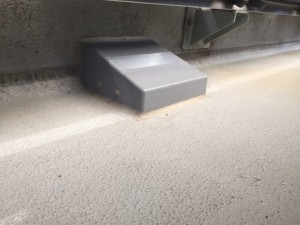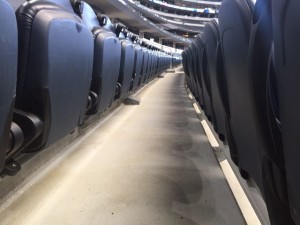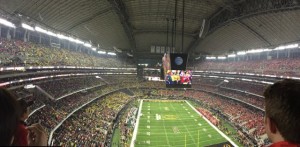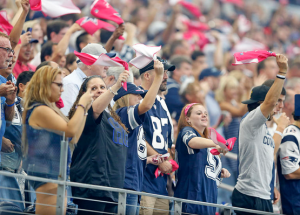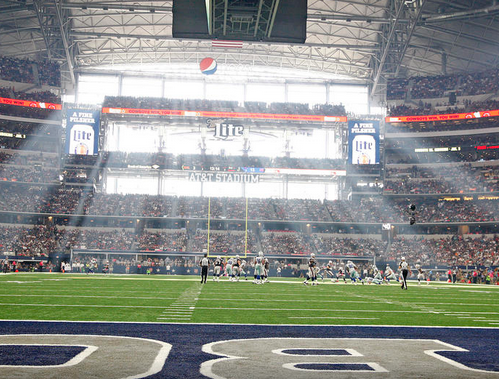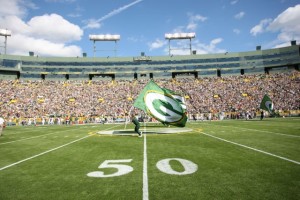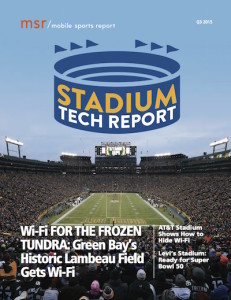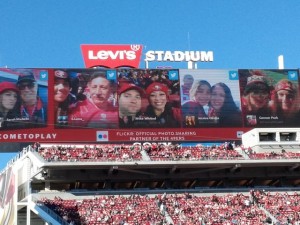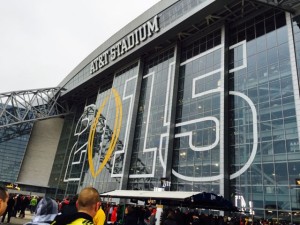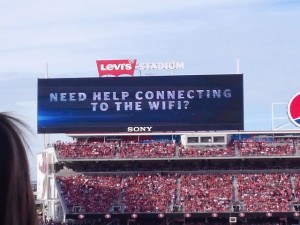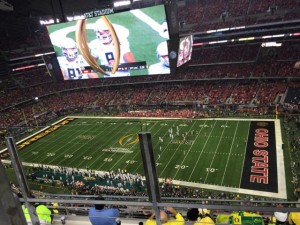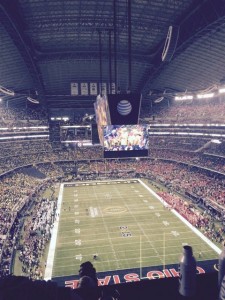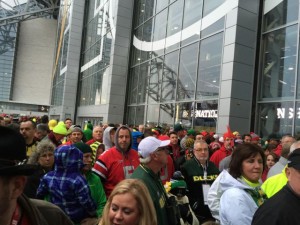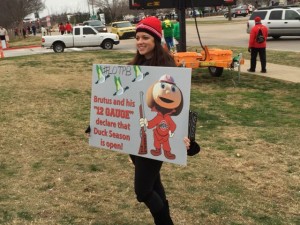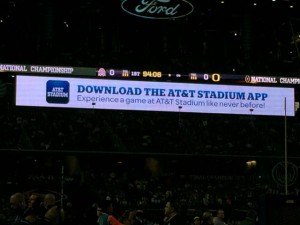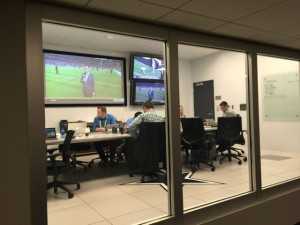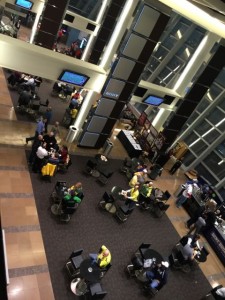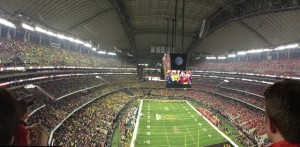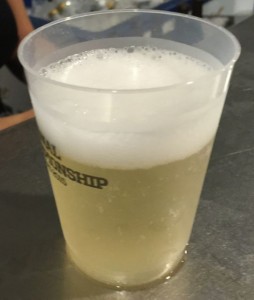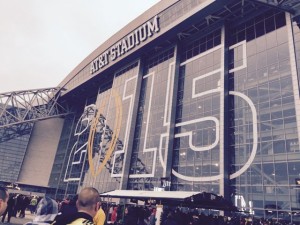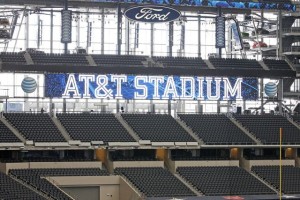
Wi-Fi antennas visible under the ‘shroud’ covering the outside of the overhang at AT&T Stadium. Photo: Dallas Cowboys (Click on any photo for a larger image)
To just above the first and second seating levels of the stadium, that is.
Even though the venue has more Wi-Fi APs than any sports stadium we’ve ever heard of, trying to find any of the 1,900 permanently installed APs is a tough task, thanks to measures like the fiberglass shrouds that circle the stadium just above the first and second seating levels. Underneath those custom-built coverings are numerous Wi-Fi APs, DAS antennas and even cameras, all contributing to the high level of connectivity inside AT&T Stadium while remaining invisible to the visiting fan’s eyes.
“The philosophy throughout the stadium is for a clean, stark look,” said John Winborn, chief information officer for the Dallas Cowboys Football Club, which is the primary tenant of the venue. “That’s a high standard, and that is a real challenge for us when it comes to Wi-Fi and DAS.”
In just about every stadium network deployment we write about, concealment and aesthetics are always one of the top concerns, especially when it comes to Wi-Fi access points and DAS antennas. For some reason, the physical appearance of an obvious piece of technology evokes strong reactions, even as other necessary structural items are ignored.
(Editor’s note: This story is an excerpt from our most recent Stadium Tech Report, the PRO FOOTBALL ISSUE, which is available for FREE DOWNLOAD right now from our site. In the report our editorial coverage includes a profile of the new Wi-Fi network at Green Bay’s Lambeau Field and team-by-team profiles of Wi-Fi and DAS deployments at all 31 NFL stadiums. Get your copy today!)
A clean, sleek look at the house that Jerry built
As one anonymous commentator at this summer’s SEAT conference noted, “stadium supervisors don’t ever care about seeing a 4-inch pipe, but leave one antenna out and they go crazy.” And whoever that stadium person is, he or she probably has a kindred soul in Dallas Cowboys owner Jerry Jones.
An unseen antenna is Jerry Jones’ favorite kind. Winborn said that AT&T Stadium embraces design in all things visible, noting that the “clean look” idea extends to advertising inside the seating bowl, where the only permanent signs are located in the end zone areas.
“We’re very conscious of the aesthetics here,” Winborn said. “Everyone here sees the benefit of what a great looking building can be. And it all starts with [Jerry] Jones.” Jones’ ideas, Winborn said, “are a major influence on everything we do.”
What that means when it comes to Wi-Fi is that while the stadium always aims to be the best-connected venue around – for this football season, AT&T Stadium will have 1,900+ permanent Wi-Fi APs and another 100 or so available for temporary placements – it also aims to hide the physical gear as much as possible. In suites and hallways there is the natural solution of putting antennas behind ceiling panels, but in the seating bowl, Winborn said, “we don’t have a lot of areas to hide them. We’ve had to become pretty clever about ways to hide APs.”
Two years ago, when the stadium’s AP count was going up from 750 to 1,250, the idea came about to design a custom fiberglass “shroud” that would circle the arena on the front of the overhangs above the first and second seating levels.
“We’re very conscious of the aesthetics here,” Winborn said. “Everyone here sees the benefit of what a great looking building can be.Winborn said one of the IT staff members had contacts in the manufacturing world, which helped the Cowboys build a slighly convex design that wouldn’t be readily apparent to the untrained eye, yet be big enough to house Wi-Fi and DAS gear all the way around the bowl.
Winborn said the shroud and its underlying gear were installed during one of the recent off-seasons, taking about a couple months – and the final result was so good that Winborn says he needs to use a laser pointer to show interested parties exactly where the equipment shroud sits. Since it’s fiberglass the shroud is somewhat easy to move to allow administration and maintenance of the equipment, but the seamless flow of the structure around the bowl may just be the most elegant AP hiding strategy in the short history of stadium Wi-Fi.
But even with the shrouds there was still a need for more new placements, especially in the middle of the open seating areas. So last year the AT&T Stadium team started deploying under-seat AP enclosures, working with design teams at the AT&T Foundry program to build a custom unit that is much smaller and unobtrusive than other under-seat AP enclosures currently in use.
“We worked with the AT&T Foundry and went through [testing] about a half-dozen models,” Winborn said, before finally arriving at a design that worked well and stayed small. “It’s about the size of a small cigar box,” said Winborn of the under-seat APs, 300 of which were installed in the 100-level seating last year. Another 250 are being installed for this year up in the 300-level seating, he said.
Winborn credited the early use of under-seat APs by the IT team at AT&T Park in San Francisco as a welcome guide.
“I talked to the Giants and Bill [Schlough, the Giants’ CIO] and had my concerns” about under-seat APs, Winborn said. “But after they did it and had only one complaint in 2 years, that raised my comfort level.”Like the Giants’ under-seat APs, the ones in AT&T Stadium are designed to be as maintenance-free as possible, so that they can be steam washed and not harmed by spills or any other physical interactions. Winborn said the Cowboys have even started putting sealant and paint over the top of the under-seat APs, “so they look just like a bump.”
With 1,900 to 2,000 APs available, it might seem like the AT&T Stadium IT crew has enough APs for now, so they can relax a bit when it comes to finding new ways to hide Wi-Fi gear. But Winborn knows the next surge is probably right around the corner (including early results from this season showing 4+ terabytes of Wi-Fi use).
“Everything we are giving the fans [in Wi-Fi bandwidth] they are gobbling it up, pretty quickly,” Winborn said.
